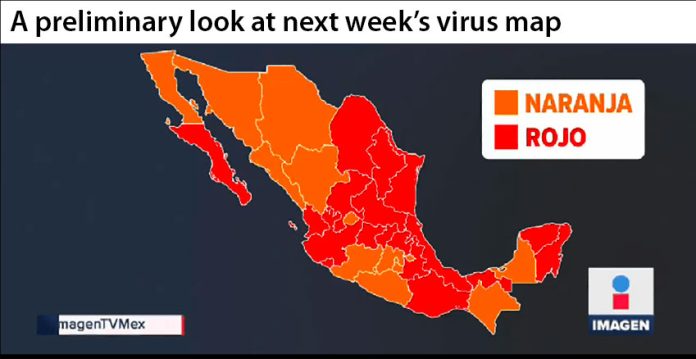Nine states will switch from “orange light” high risk to “red light” maximum risk on the federal government’s new coronavirus “stoplight” map to be presented Friday night if no changes are made to a draft version shown to governors on Thursday.
Baja California Sur, Hidalgo, Jalisco, Oaxaca, Querétaro, Quintana Roo, San Luis Potosí, Yucatán and Zacatecas are slated to revert to red, the newspaper Reforma reported.
Deputy Health Minister Hugo López-Gatell said this week that the “stoplight” map would continue to be updated on a weekly basis – even though it wasn’t revised last week – but several governors told Reforma that the stoplight colors allocated to each state, and the accompanying recommended restrictions to slow the spread of the coronavirus, will now apply for two weeks.
According to the proposed map, Coahuila, Colima, Guanajuato, Nayarit, Nuevo León, Puebla, Tabasco, Tamaulipas and Veracruz will retain their current status as “red light” states.
Six other states currently painted red are slated to switch to orange. They are Baja California, Chiapas, México state, Sinaloa, Sonora and Tlaxcala.
If their risk rating is downgraded, they will join Aguascalientes, Campeche, Chihuahua, Mexico City, Durango, Guerrero, Michoacán and Morelos as “orange light” states. The draft map shown to governors by federal health authorities proposed that those states keep their current high-risk rating.
If the proposed map becomes the official one, there will be 18 “red light” states, an increase of three compared to the map currently in force, and 14 “orange light” ones.
The government considers four factors when determining the risk level and corresponding stoplight color for each state: case number trends (whether new infections are increasing, decreasing or stable), hospital admission trends for coronavirus patients, hospital occupancy levels and positivity rates (the percentage of people tested who are confirmed to have Covid-19).
Among the governors who said that the updated map will apply for two weeks were Omar Fayad of Hidalgo and José Rosas Aispuro of Durango.
“There is already an agreement [that] the stoplight [map] will be made public every 15 days,” Fayad said before adding that a state’s stoplight color could still be updated on a weekly basis in certain circumstances.
Rosas also said that federal and state authorities agreed that the stoplight map would be published every two weeks, “with the understanding that if a state needs to modify it before, it will be able to.”
As of Thursday, Mexico had recorded more than 320,000 confirmed coronavirus cases and 37,574 deaths.
Source: Reforma (sp)
